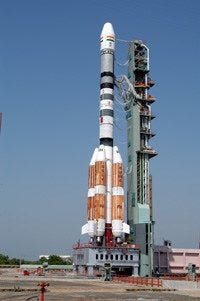India’s Place in Space: It’s GSLV or Bust
You don’t have to be a rocket scientist to understand why India’s heavy lift GSLV (or Geo-Stationary Launch Vehicle) blew up a minute after liftoff last Christmas. There are two explanations – one, obvious and the other, rather disturbing.
The obvious reason is that experimental rockets are known to behave erratically, and the GSLV is still a work in progress. The Russian and American space programmes were also bedevilled by spectacular rocket failures.
But there’s a more disturbing reason. The GSLV’s ugly record of four crashes out of seven launches in nine years points to an ambitious space programme that has been shockingly underfunded and given the step-motherly treatment by India’s political leadership.
Paucity of funds has been a key factor holding back Indian rocketry. The $1.2 billion allocation in this year’s budget was the highest ever, according to the Indian Space Research Organisation (ISRO). That amounts to just 3 percent of the funding earmarked by the US space programme.
A country with a GDP of over $5,200 billion allocates a measly $1.2 billion from which ISRO has to pay salaries to its 16,000 employees, build homes for them, pay utilities and, oh yes, with what is left, build the odd rocket or moon rover.
Another possible reason why the political leadership ignores space is that India’s highly indigenised space sector doesn’t offer scope for king-sized kickbacks, as is common in defence deals.
In fact, the scientists and engineers behind Chandrayaan I, India’s first deep space mission, which discovered water on the moon last year, were conspicuously missing from the 2010 Padma Awards. And adding insult to injury, Prime Minister Manmohan Singh’s doctor, with no known contribution to the nation, figured in the list. Again, you don’t have to be a rocket scientist to figure how the PM’s flunky made it to the list.
Incidentally, the success of India’s first expedition to the moon was achieved for the ridiculously low cost of $107 million whereas a similar America mission in 2010 has been tagged at more than $907 million.
Shoestring budgets aside, the Indian space programme has also been hamstrung by decades of Western sanctions. This virtual boycott increases the time frame for manufacturing satellites, rockets and other systems.
This is where India’s political leadership has let the nation down. Western countries had their own geopolitical reasons to deny India high technology, but what was New Delhi doing during the heady days of India-Russia bonhomie? Indeed, if Moscow could be relied upon to check American and Chinese bullying if India went to war – as was spelt out in the 1971 Indo-Soviet Friendship Treaty – what prevented New Delhi from asking for the transfer of rocket technology? Even if the West had a pact with Moscow to prevent missile and nuclear technology from falling into India’s hands, what prevented us from circumventing those laws?
Nations beg, borrow and steal the technology they lack. In the 18th century, the British learned how to make better rockets, ships and steel from India. After World War II, captured German scientists formed the basis of rocketry at NASA and to some extent in Russia. The joke at NASA was that the Americans were working the German scientists 24 hours a day while the Russians were flogging them 48 hours a day, which was presumably the reason why Russia scored so many firsts in space!
India missed the bus again in 1991 when an imploding Soviet Union was hawking the crown jewels of its space industry. Expertise, products and experience were available to the highest bidder. Heat shields, re-entry capsules, cosmonaut suits, orbital docking systems, compact nuclear reactors – you name it, Moscow had it on sale.
NASA grabbed the opportunity to buy, among other things, the world’s largest rocket engines, which will be at the core of its post-Shuttle programme. As an American administration official said at that time, “A few years ago, we were trying to steal these technologies. To miss this opportunity would be insane.” The serious glitches involved in the GSLV programme could have been avoided if India had acquired this rocket.
Just 12 years after that fire sale, China was able to send a two-man crew into orbit. There is no evidence that India’s leadership was even aware of all this.
To ISRO’s credit, however, it has become the master of indigenisation. India is a world leader in remote sensing and its constellation of communication and ground imaging satellites is the largest in the world. In December 1998 in the aftermath of the American bombing of the Iraqi military HQ in Baghdad, pictures of the destruction caused came from a most unexpected source – IRS 1C, India’s powerful remote sensing satellite. American experts were stunned by how quickly India had managed to manoeuvre IRS 1C over Baghdad. One commented: “I don’t know how they did it but when we were bombing Baghdad, the Indians were the only game in town.”
Today India has become a major launcher, with its medium lift PSLV rocket injecting 10 satellites into orbit in one go, which is some sort of record.
However, India better get its GSLV act right. For, the fate of the planned manned mission to the moon by 2020 and to Mars in 2030 rests on this behemoth. A manned test flight is slotted for 2016, for which India’s vyomanauts – vyom means space in Sanskrit – are undergoing training near Bangalore.
In the medieval period, India despite its considerable wealth, resources and achievements in science and technology, blithely looked the other way as Western nations colonised large parts of the earth. Indeed, that lack of forward policy was the chief reason why India itself got colonised. Space is the next big territory, with the Chinese, Americans, and even the declining Europeans and Japanese wanting more than a handful of moon dust. India must not remain a spectator during this round of colonisation.




